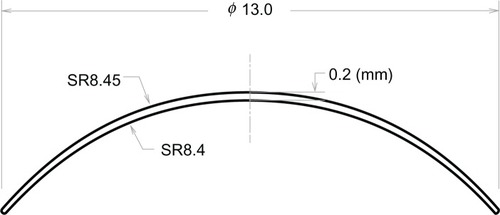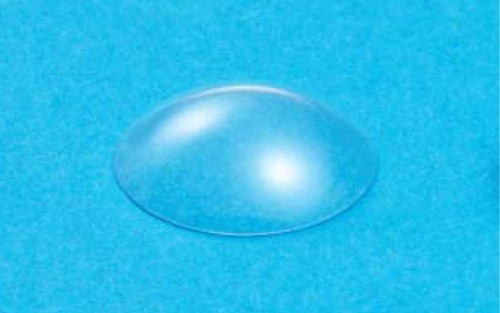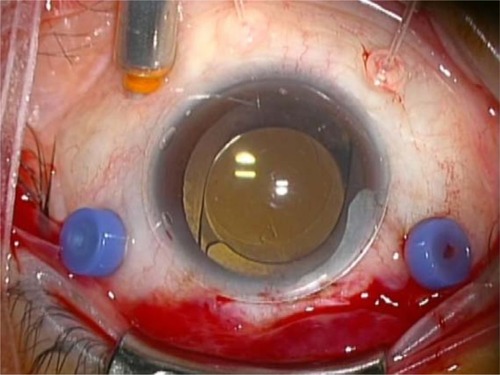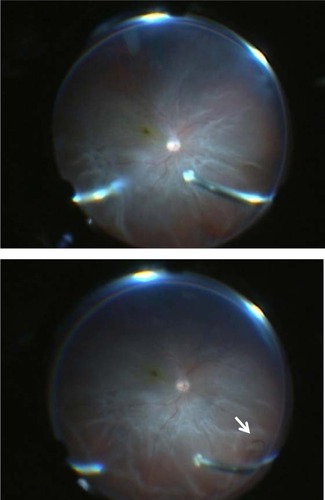Abstract
Drying of the cornea during surgery, which causes poor visibility of the fundus, is one of the more serious problems when using a noncontact type wide-angle viewing system. We developed an antidrying corneal contact lens for use with this type of viewing system. The lens has a very thin meniscus made of polymethyl methacrylate with a large outer diameter. Following application of the viscoelastic material, the lens can be put on the cornea without using a contact lens fixation ring. The larger diameter and lightweight characteristics of our lens contributed to its overall stability. The smooth surface of this prototype lens was able to achieve an intraoperative view of good quality, not only by preventing the cornea from drying, but also by providing a smooth surface over the entire cornea.
Introduction
A clear fundus image of the surgical field is one of the most important factors influencing the surgical outcome. Recently, use of a wide-angle viewing system has become popular, because it can easily provide a panoramic view of the surgical field. Two types of wide-angle viewing system exist, with both contact and noncontact types available.Citation1–Citation3 While the contact type provides greater optical resolution and a wider field of view, the noncontact type is more popular because of the stability of the image against the tilt of the eyeball and the ease of manipulation. However, drying of the cornea during surgery, which causes poor visibility of the fundus, is one of the more serious problems when using the noncontact type. We have developed a new type of antidrying corneal contact lens that can be used with a noncontact wide-angle viewing system.
Materials and methods
Contact lens design
We developed an extremely thin corneal contact lens that has a 0.2 mm thickness at the center and a clear meniscus made of polymethyl methacrylate. The lens has a loose curve that measures 8.45 mm for the front curve radius and 8.40 mm for the back curve radius, along with a large outer diameter that measures 13.0 mm ( and ). This lens was designed to have a refractive power of zero.
Surgical procedure
We performed lensectomy, intraocular lens implantation, and 23-gauge pars plana vitrectomy with a wide-angle viewing system (Resight®, Carl Zeiss Meditec AG, Jena, Germany). To protect the cornea from drying, viscoelastic material was applied to the corneal surface, with the lens then positioned on top without any fixation ring required to hold it in place ().
Results
This new type of corneal contact lens provided clear images of the surgical field without any drying of the cornea. The fundus area that was viewed with a combination of the contact lens and a wide-angle viewing system tended to be wider than the area available when using the wide-angle viewing system alone ().
Discussion
During operations using the noncontact type of wide-angle viewing system, continuous hydration of the cornea by an assistant or application of a viscoelastic material to the corneal surface is necessary if a clear view is to be maintained. However, the irregular surface of the viscoelastic material can lead to a poor quality of vision for the surgical field.
Recently, the usefulness of several types of corneal contact lenses that can overcome drying of the cornea has been demonstrated. Ohji et alCitation4 and OhnoCitation5 reported that use of a magnifying vitrectomy contact lens was advantageous, because it provided a wider fundus view in combination with the wide-angle viewing system. In their system, a magnifying contact lens is held on the cornea using a lens holder or a fixating ring. Kamei et alCitation6 compared a commercially available rigid gas-permeable contact lens (−3 diopters) with a system that used a balanced salt solution, a viscoelastic agent, a vitrectomy contact lens, and a soft contact lens, and found the rigid gas-permeable contact lens to be ideal for use during vitrectomy when performed with a wide-angle viewing system. The rigid gas-permeable contact lens is designed to be movable on the cornea in order to prevent hypoxic corneal damage in daily use. However, the lens might be unstable on the cornea during surgery, which seems disadvantageous when it is used in vitrectomy.
Ohno et alCitation7 developed a new antidrying contact lens made of quartz with a diameter of 11.2 mm and a thickness of 1.0 mm. However, this lens still requires use of a contact lens fixation system. One of the disadvantages of using a quartz lens is its thickness, and because of its weight, this small diameter lens tends to show poor centering on the cornea. To overcome this problem, a contact lens fixation system is required when using the quartz lens. In contrast, the outer diameter of our lens is much larger, which leads to stabilization and prevents displacement of the lens without having to use a contact lens fixation ring. In addition, the very thin and lightweight characteristics of polymethyl methacrylate may also help contribute to the overall stabilization.
Because this prototype lens was designed to have a refractive power of zero on the cornea, no disadvantageous changes are seen in the panoramic view. Thus, the design of this lens makes it possible to achieve a good quality intraoperative view, not only by preventing the cornea from becoming too dry, but also by providing a smooth surface over the entire cornea. Therefore, this lens might be suitable for cases having a rough cornea following trauma or laser-assisted in situ keratomileusis, or during prolonged surgical procedures.
When calculating the area of the fundus to be visualized using a ray tracing method, our contact lens with the wide-angle viewing system (+128 diopters) provided a 109.9 and 133.7 degree fundus view, while the wide-angle viewing system alone provided a 108.1 and 125.9 degree fundus view in pseudophakic (+20 diopters, 6 mm in diameter) and aphakic eyes, respectively (). During the simulation, use of this lens led to a slightly wider field of intraoperative view, which could be another advantageous aspect when using our contact lens.
Table 1 Simulation of the fundus visual angle and magnification in the wide-angle viewing system (+128 diopters) alone and in our contact lens with the wide-angle viewing system for pseudophakia (+20 diopters, 6 mm in diameter) and aphakia
In summary, this promising new lens can be used as an antidrying device during vitreous surgery with a noncontact wide-angle viewing system.
Acknowledgements
The authors appreciate Hoya Corporation (Tokyo, Japan) for making a prototype contact lens from our design and cooperating in calculation of fundus views.
Disclosure
The authors report no conflicts of interest in this work.
References
- NakataKOhjiMIkunoYWide-angle viewing lens for vitrectomyAm J Ophthalmol200413776076215059723
- SpitznasMA binocular indirect ophthalmomicroscope (BIOM) for noncontact wide-angle vitreous surgeryGraefes Arch Clin Exp Ophthalmol198722513153569944
- LandersMBPeymanGAWesselsIFWhalenPMoralesVA new, noncontact wide field viewing system for vitreous surgeryAm J Ophthalmol20031361191119214644251
- OhjiMTadaEFutamuraHCombining a contact lens and wide-angle viewing system for a wider fundus viewRetina2011311958196021811204
- OhnoHCombined use of high-reflective index vitrectomy meniscus contact lens and a noncontact wide-angle viewing system in vitreous surgeryClin Ophthalmol201151109111121887090
- KameiMMatsumuraNSakaguchiHOshimaYIkunoYNishidaKCommercially available rigid gas-permeable contact lens for protecting the cornea from drying during vitrectomy with a wide viewing systemClin Ophthalmol201261321132422969277
- OhnoHInoueKAn antidrying corneal contact lens for a noncontact wide-angle viewing systemRetina2011311435143621836414



